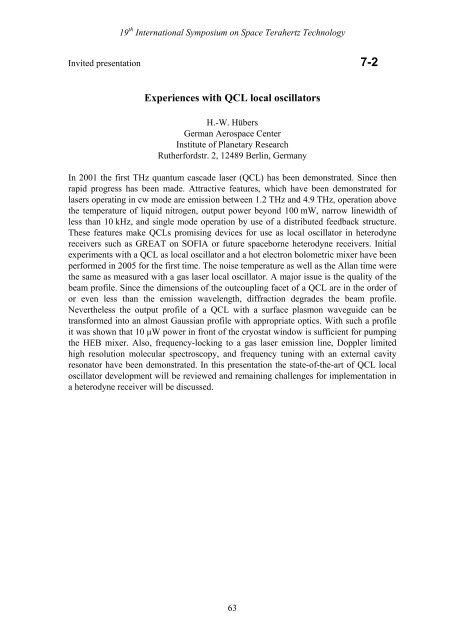Program and Abstract Book - SRON
Program and Abstract Book - SRON
Program and Abstract Book - SRON
Create successful ePaper yourself
Turn your PDF publications into a flip-book with our unique Google optimized e-Paper software.
19 th International Symposium on Space Terahertz Technology<br />
Invited presentation 7-2<br />
Experiences with QCL local oscillators<br />
H.-W. Hübers<br />
German Aerospace Center<br />
Institute of Planetary Research<br />
Rutherfordstr. 2, 12489 Berlin, Germany<br />
In 2001 the first THz quantum cascade laser (QCL) has been demonstrated. Since then<br />
rapid progress has been made. Attractive features, which have been demonstrated for<br />
lasers operating in cw mode are emission between 1.2 THz <strong>and</strong> 4.9 THz, operation above<br />
the temperature of liquid nitrogen, output power beyond 100 mW, narrow linewidth of<br />
less than 10 kHz, <strong>and</strong> single mode operation by use of a distributed feedback structure.<br />
These features make QCLs promising devices for use as local oscillator in heterodyne<br />
receivers such as GREAT on SOFIA or future spaceborne heterodyne receivers. Initial<br />
experiments with a QCL as local oscillator <strong>and</strong> a hot electron bolometric mixer have been<br />
performed in 2005 for the first time. The noise temperature as well as the Allan time were<br />
the same as measured with a gas laser local oscillator. A major issue is the quality of the<br />
beam profile. Since the dimensions of the outcoupling facet of a QCL are in the order of<br />
or even less than the emission wavelength, diffraction degrades the beam profile.<br />
Nevertheless the output profile of a QCL with a surface plasmon waveguide can be<br />
transformed into an almost Gaussian profile with appropriate optics. With such a profile<br />
it was shown that 10 µW power in front of the cryostat window is sufficient for pumping<br />
the HEB mixer. Also, frequency-locking to a gas laser emission line, Doppler limited<br />
high resolution molecular spectroscopy, <strong>and</strong> frequency tuning with an external cavity<br />
resonator have been demonstrated. In this presentation the state-of-the-art of QCL local<br />
oscillator development will be reviewed <strong>and</strong> remaining challenges for implementation in<br />
a heterodyne receiver will be discussed.<br />
63
















